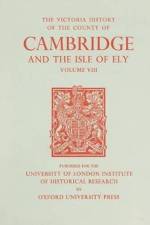- Volume VIII: Armingford and Thriplow Hundreds
av A. P. M. Wright
1 181
This volume covers the two hundreds of Armingford and Thriplow in south-west Cam-bridgeshire. They comprise 23 ancient parishes, lying between the Gogmagog Hills south-east of Cambridge, where an Iron Age hill fort partly survives, and the clay-covered West Cambridge-shire upland. To the north-west they are largely bounded by the Cam or Rhee, to the south by heathlend along the Icknield Way. The land has long been used mainly for arable farming. Some of the villages, which are mostly nucleated, may stand near the sites of Roman or earlier settlement. Those in the far west had some dependent hamlets, mostly vanished long ago. In that area several villages, after the early inclosureof their poor, heavy soils for pasturage, shrank greatly or, as at Clopton and Shingay, became. entirely deserted. Elsewhere open fields survived until the early 19th century. Later in that century coprolites were widely dug; in the 20th com-mercial fruit growing was introduced; the chalk has been dug to make cement and whiting; and some of the larger villages, such as Melbourn, have attracted light industry. During the Second World War much level ground was taken over for airfields. The churches of the area range from the humble early Norman work at Hauxton, through cruciform 13th-century buildings, as at Fowlrnere, to the stately Decorated of Trumpington and Bassingbourn. The Igth century saw much rebuilding and refurnishing, sometimes financed by local religious plays. Several villages retain much timber framed vernacular building. The only aristocratic mansion, Gogmagog House of the dukes of Leeds at Wandlebury, has been demolished, but lesser houses include some well preserved late medieval manor houses and much good, plain Georgian work, as at Trumpington Hall, seat of the Pembertons. The villages near Cambridge have been greatly affected in the 20th century by the spread of population.


